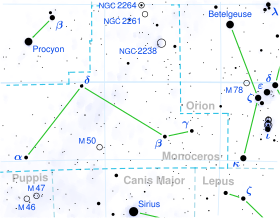Beta Monocerotis (Beta Mon, β Monocerotis, β Mon) is a triple star system in the constellation of Monoceros.[14] To the naked eye, it appears as a single star with an apparent visual magnitude of approximately 3.74, making it the brightest visible star in the constellation.[7] A telescope shows a curved line of three pale blue stars (or pale yellow stars, depending on the scope's focus). William Herschel who discovered it in 1781 commented that it is "one of the most beautiful sights in the heavens".[20] The star system consists of three Be stars, β Monocerotis A, β Monocerotis B, and β Monocerotis C. There is also an additional visual companion star that is probably not physically close to the other three stars.[14]
- ^ a b Entry, component 1, HIP 30867, The Hipparcos and Tycho Catalogues, 1997, CDS ID I/239, accessed on line November 21, 2008.
- ^ a b c Ducati, J. R (2002). "VizieR Online Data Catalog: Catalogue of Stellar Photometry in Johnson's 11-color system". CDS/ADC Collection of Electronic Catalogues. 2237. Bibcode:2002yCat.2237....0D.
- ^ Entry, component 2, HIP 30867, The Hipparcos and Tycho Catalogues, 1997, CDS ID I/239, accessed on line November 21, 2008.
- ^ a b c d HR 2357, database entry, The Bright Star Catalogue, 5th Revised Ed. (Preliminary Version), D. Hoffleit and W. H. Warren, Jr., CDS ID V/50. Accessed on line November 21, 2008.
- ^ a b Entry, component 3, HIP 30867, The Hipparcos and Tycho Catalogues, 1997, CDS ID I/239, accessed on line November 21, 2008.
- ^ Slettebak, A (1982). "Spectral types and rotational velocities of the brighter Be stars and A-F type shell stars". Astrophysical Journal Supplement Series. 50: 55. Bibcode:1982ApJS...50...55S. doi:10.1086/190820.
- ^ a b c d e HR 2356, database entry, The Bright Star Catalogue, 5th Revised Ed. (Preliminary Version), D. Hoffleit and W. H. Warren, Jr., CDS ID V/50. Accessed on line November 21, 2008.
- ^ a b Cowley, A; Gugula, E (1973). "Cyclic variations of the Be star beta 1 Monocerotis". Astronomy and Astrophysics. 22: 203. Bibcode:1973A&A....22..203C.
- ^ "* bet Mon C". SIMBAD. Centre de données astronomiques de Strasbourg. Retrieved November 21, 2008.
- ^ Gontcharov, G. A (2006). "Pulkovo Compilation of Radial Velocities for 35 495 Hipparcos stars in a common system". Astronomy Letters. 32 (11): 759–771. arXiv:1606.08053. Bibcode:2006AstL...32..759G. doi:10.1134/S1063773706110065. S2CID 119231169.
- ^ a b c Van Leeuwen, F (2007). "Validation of the new Hipparcos reduction". Astronomy and Astrophysics. 474 (2): 653–664. arXiv:0708.1752. Bibcode:2007A&A...474..653V. doi:10.1051/0004-6361:20078357. S2CID 18759600.
- ^ Fabregat, J; Reglero, V (1990). "Determination of Be-Star Parameters from Uvby-Beta Photometry and Hα Equivalent Widths". Monthly Notices of the Royal Astronomical Society. 247: 407. Bibcode:1990MNRAS.247..407F.
- ^ a b Tetzlaff, N; Neuhäuser, R; Hohle, M. M (2011). "A catalogue of young runaway Hipparcos stars within 3 kpc from the Sun". Monthly Notices of the Royal Astronomical Society. 410 (1): 190–200. arXiv:1007.4883. Bibcode:2011MNRAS.410..190T. doi:10.1111/j.1365-2966.2010.17434.x. S2CID 118629873.
- ^ a b c d e f g Jim Kaler. "Beta Mon". Stars. Retrieved 2018-01-29.
- ^ a b Zorec, J; Frémat, Y; Cidale, L (2005). "On the evolutionary status of Be stars. I. Field Be stars near the Sun". Astronomy and Astrophysics. 441 (1): 235–248. arXiv:astro-ph/0509119. Bibcode:2005A&A...441..235Z. doi:10.1051/0004-6361:20053051. S2CID 17592657.
- ^ Frémat, Y; Zorec, J; Hubert, A.-M; Floquet, M (2005). "Effects of gravitational darkening on the determination of fundamental parameters in fast-rotating B-type stars". Astronomy and Astrophysics. 440 (1): 305. arXiv:astro-ph/0503381. Bibcode:2005A&A...440..305F. doi:10.1051/0004-6361:20042229. S2CID 19016751.
- ^ HR 2358, database entry, The Bright Star Catalogue, 5th Revised Ed. (Preliminary Version), D. Hoffleit and W. H. Warren, Jr., CDS ID V/50. Accessed on line November 21, 2008.
- ^ "* bet01 Mon". SIMBAD. Centre de données astronomiques de Strasbourg. Retrieved November 21, 2008.
- ^ Entry 06288-0702, The Washington Double Star Catalog Archived 2009-01-31 at the Wayback Machine, United States Naval Observatory. Accessed on line November 21, 2008.
- ^ Proctor, Richard Anthony (1879). Half-hours with the Telescope: A Popular Guide to the Use of the Telescope as a Means of Amusement and Instruction. G. P. Putnam's sons.
Cite error: There are <ref group=note> tags on this page, but the references will not show without a {{reflist|group=note}} template (see the help page).
